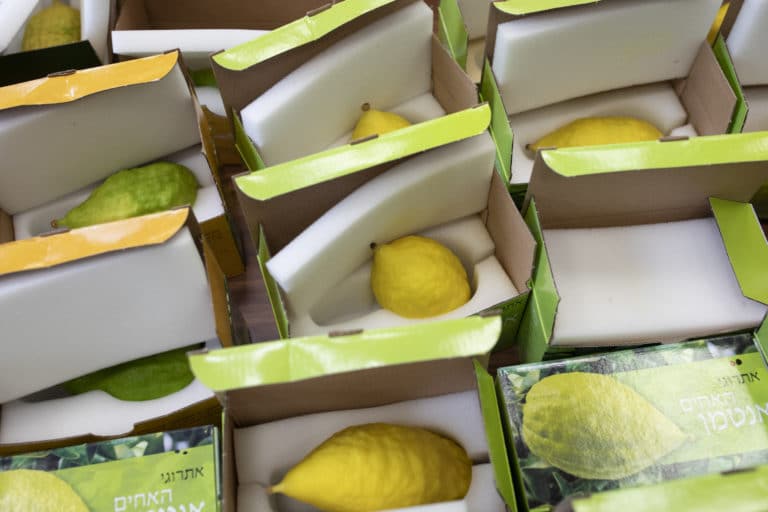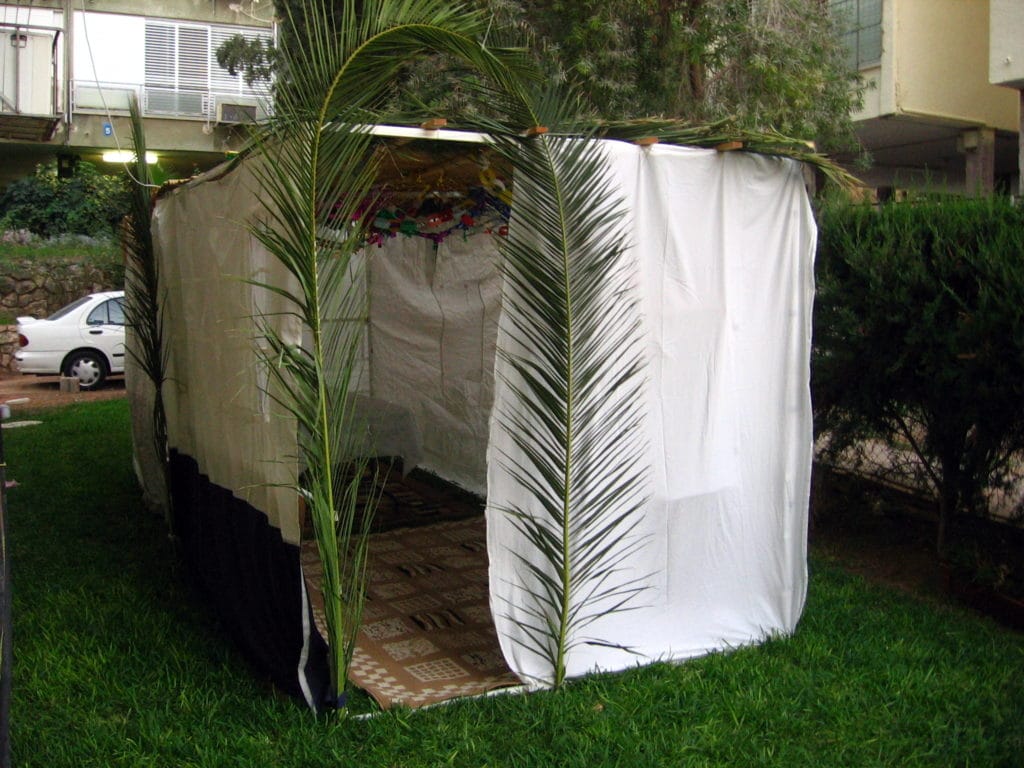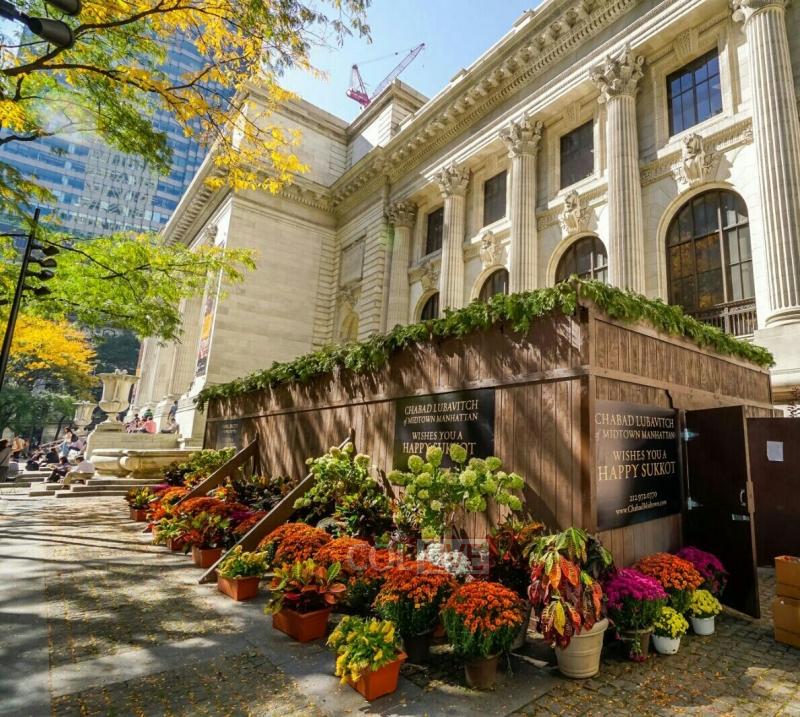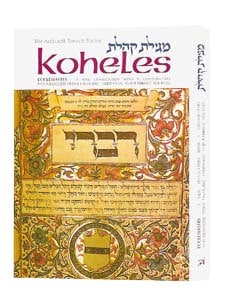
Sukkot is a week-long festival that integrates themes of joy and insecurity. Here’s a rundown of everything you need to know.
Read more: Get our guides to all the Jewish holidays.
What is Sukkot?

Sukkot means “booths” or “huts” in Hebrew and is named for the temporary structures in which Jews “dwell” during the holiday. Meals are eaten in the sukkah, and many choose to sleep, read and hang out in them as well. According to a tradition from the Talmud, the sukkah represents the portable huts or tabernacles in which the Israelites lived during the 40 years they wandered the desert.
Sukkot combines themes of joy and vulnerability. It is a joyful holiday, a time when we focus on the simple pleasure of being close to nature and with family and friends.
The Torah (Devarim/Deuteronomy 16: 13-15) establishes Sukkot as a joyful holiday: “You shall hold Chag HaSukkot for seven days… You shall rejoice in your festival… and you shall have nothing but joy.”
At the same time, Sukkot is a holiday of vulnerability and insecurity, recalling the fragile condition of the Israelites wandering in the desert and their total reliance on God.
Sukkot is one of three Pilgrimage Festivals (major holidays mentioned in the Torah on which Jews would travel to the ancient Temple in Jerusalem). The other two Pilgrimage Festivals are Pesach (Passover) and Shavuot (Feast of Weeks). Although Sukkot is the most common name of this holiday, it is also called Chag Ha-asif (“the Feast of Ingathering”). This refers to rejoicing and thanking God in the period after the crops had been harvested. In Yiddish the holiday is often referred to as “Sukkus,” and many Jews of Ashkenazi descent pronounce it that way.
When is Sukkot 2024?
Sukkot begins on the 15th day of the Hebrew month of Tishrei (five days after Yom Kippur) and is celebrated for seven days. It starts the evening of Wednesday, Oct. 16, 2024, and goes through the evening of Wednesday, Oct. 23, 2024.
The first day (and first and second days in the Diaspora) are celebrated as full holidays with prohibitions against work. The following days are called Chol Hamoed (weekdays of the festival), during which work is generally allowed and observances of Sukkot continue. This is followed by Shemini Atzeret (the “Eighth Day of Assembly”) and Simchat Torah (“Rejoicing in Torah”), which are celebrated as one day in Israel and two days in the Diaspora.
How to wish someone a happy Sukkot
To greet someone during Sukkot, you can simply say “Happy Sukkot” or use the following:
- Chag sameach (Happy holiday)
- Chag Sukkot sameach (Happy Sukkot)
- Moadim L’simcha — This literally means “times of joy” but is used to wish someone a happy holiday. Use this during Chol Hamo-ed (the intermediate days of Sukkot). If someone says this to you, you can reply with the traditional response, “chagim u’zmanim l’sasson” (“holidays and times for celebration”).
Why do we dwell in a sukkah?

The Torah (Vayikra/Leviticus 23: 42-43) states, “You shall live in sukkot (booths) seven days; all citizens in Israel shall live in sukkot, in order that future generations may know that I made the Israelite people live in sukkot when I brought them out of the land of Egypt.”
There is a debate in the Talmud (Sukkah 11b) about the nature of the “sukkot” in which the Israelites dwelled. While Rabbi Akiva believed that they were sukkot mamash (actual booths or huts), Rabbi Eliezer maintained that they were ananei kavod (clouds of glory) that surrounded and protected the Israelites while they wandered in the desert.
Two different reasons for dwelling in a sukkah emerge from these interpretations. If we follow Rabbi Eliezer’s interpretation, then we sit in a sukkah to remember the miracles that God performed in protecting the Israelites on their journey through the desert.
If we use Rabbi Avika’s interpretation, then we sit in a sukkah to remember the Israelites’ vulnerable condition of living in flimsy huts in the desert, and their complete faith in God. Rabbi Yechiel Michel Epstein (born in 1829 in Babruysk, Russian Empire, which is present-day Belarus) explained that we dwell in sukkot in order “to reveal and publicize the greatness of” the Israelites who traveled in the desert when “they did not even have permanent housing, rather mere sukkot,” and trusted completely in God (Arukh HaShulchan, Orach Hayyim 625:3).
Here are a few other explanations of why we dwell in a sukkah:
- In his Guide to the Perplexed (3:47), the medieval scholar Rambam (Maimonides) wrote that sitting in a sukkah “teaches man to remember his evil days in his day of prosperity. He will thereby be induced to thank God repeatedly and to lead a modest and humble life.”
- The medieval Talmudic scholar Rabbi Isaac Aboab wrote that sitting in a sukkah reaffirms our faith in God: “The sukkah is designed to warn us that man is not to put his trust in the size or strength or beauty of his home, though it be filled with all precious things; nor must he rely upon the help of any human being, however powerful. But let him put his trust in the great God whose word called the universe into being for He alone is mighty, and His promises alone are sure.”
- Rabbi Adin Steinsaltz wrote that sitting in a sukkah is an expression of a “love affair” with God: “The sukkah, in its physical form, is, in a way, a hug. The inner sense of the holiday of Sukkot is not one of remembering anything in particular, but welcoming the divine hug.”
How to build a sukkah
It is traditional to start building a sukkah as soon as possible after the end of Yom Kippur. According to the Shulchan Arukh, a code of Jewish law by Rabbi Joseph Karo (born in 1488 in Spain), this is based on the principle, “Mitzvah haba’ah liyadcha al tachmitsena” (“If an opportunity to perform a mitzvah presents itself to you, do not be slow in performing it”) (Orach Hayyim 625).
A sukkah must be built in the open air under the sky (i.e., not in a room or under a tree). It must have at least three sides and a covering (called sekhakh), usually made of cut branches or plants. The sekhakh must be loose enough to see the stars at night, but thick enough so that the shade it provides is greater than the light let in from the sun. It is customary to decorate the sukkah based on the Talmudic idea that the mitzvot should be performed in a beautiful way: “Beautify yourself before [God] in mitzvot. Make before Him a beautiful sukkah, a beautiful lulav, a beautiful shofar…” (Shabbat 133b). For more on the laws of building a sukkah, visit Halachipedia.com.
The Four Species

In addition to dwelling in a sukkah, a person is obligated to take what are known as the four species (arba’at haminim) and shake them. This should be done ideally in the morning, but can be done at any time during the day (but not at night and not on Shabbat). The four species are below:
- Etrog (Citron)
- Lulav (Palm branch)
- Hadasim (Myrtle)
- Aravot (Willow)
The origin of this commandment is Vayikra (Leviticus) 23:40: “On the first day you shall take the product of hadar trees, branches of palm trees, boughs of leafy trees, and willows of the brook.” The Talmud (Sukkah 32b and 35a) explains that this refers to the four species. Today, the palm branch, myrtle and willow are referred to together as the lulav.
How to shake the lulav and etrog:
- Hold the lulav in your right hand and etrog in your left. Hold them together in the position in which they grow (the pitom or stem of the etrog should be facing down).
- Recite the blessing: “Barukh atah Adonai Eloheinu melekh ha’olam asher kid’shanu b’mitzvotav v’tzivanu al netilat lulav.” (“Blessed are You, Lord our God, King of the Universe, who has sanctified us with His commandments and has commanded us concerning the waving of the lulav.”)
- If it is also the first day of Sukkot, recite the following: “Barukh atah Adonai Eloheinu melekh ha’olam shehehiyanu v’kiyemanu v’higiyanu lazman hazeh.” (“Blessed are You, Lord our God, King of the Universe, who has granted us life, sustenance, and permitted us to reach this season.”)
- Then, reverse the position of the etrog so the pitom is facing upward.
- Stand facing east and shake/wave in the following order:
- East (in front of you)
- South (to your right)
- West (behind you)
- North (to your left)
- Up
- Down
The Midrash (Vayikra Rabbah 30:12) interprets the four species as symbolizing different segments of the Jewish people, and the need for unity among them:
“Just as the Etrog has taste and fragrance, so there are in Israel men who are both learned and doers of good deeds; as the Lulav, whose fruit is palatable but is without fragrance, so there are those who are learned but without good deeds; as the myrtle has a pleasant odor but is tasteless, so there are men of good deeds, but who possess no scholarship; as the willow is neither edible nor of agreeable fragrance, so there are those who are neither learned nor possessed of good deeds.” The midrash concludes that the four species / parts of the Jewish community should be “bound together [into] one grouping.”
Other things to know:
Chol Hamoed:

Chol Hamoed are the five or six intermediate days of Sukkot (depending on if you live in Israel or the Diaspora). Although work is generally permitted on these days, the observance of Sukkot continues by eating meals in the Sukkah and waving the lulav and etrog. The complete Hallel (Tehillim/Psalms 113 – 118) is recited each day of Sukkot, including Chol Hamoed.
Simchat Beit Hashoevah:
Simchat Beit Hashoevah means “happiness of the house of the water-drawing” and is a special ritual performed during the intermediate days of Sukkot. This tradition goes back to Temple times: During the Festival of Sukkot, a libation of water was poured on the altar of the Temple.
According to OU.org, “The Water Libation was performed with intense joy. Accompanying the Water Libation were festivities entitled Simchat Beit HaShoeva…The festivities were held in the Ezrat Nashim, which was the courtyard of the outer Temple…There was dancing and singing in celebration of the drawing of the water.”
Hoshana Rabbah:
Hoshana Rabbah is the last of the intermediate days of Sukkot. It is named after the many hoshanot (liturgical poems asking God to save and redeem the Jewish people) that are recited on this day. Jewish tradition has made Hoshana Rabbah a “follow-up” to Yom Kippur: it is thought to be a day when the final judgment is rendered, extending the opportunity for teshuvah beyond Yom Kippur (see our guide to Yom Kippur for more information).
Kohelet (Ecclesiastes):

It is traditional to read Kohelet (Ecclesiastes) on the Shabbat of Sukkot. The medieval Rabbi Mordechai Yaffe wrote in his Levush Malchut (Orach Hayyim 663:2) that we read Kohelet on Sukkot because “Kohelet urges people to rejoice in their portion and not run after increased wealth. A person who enjoys what he has, it is a gift from God,” and this reflects the theme of z’man simchateinu (the time of our joy).
Quotes on the meaning of Sukkot
- “Joy, the overwhelming theme of the festival, is what we feel when we know that it is a privilege simply to be alive, inhaling the intoxicating beauty of this moment amidst the profusion of nature, the teeming diversity of life and the sense of communion with those many others who share our history and our hope.” — Rabbi Jonathan Sacks
- “On Sukkot, the Festival of the Ingathering, we are commanded to dwell in the sukkah – the primordial state, in which one sees life’s simple and basic graces, and rejoices in what one has instead of making demands… This return to the primordial point, to the place from which things begin, is what enables one to attain joy. The days of Sukkot, then, are like a recipe for joy. Through the humility of putting oneself where one belongs, a person learns to appreciate life’s gifts — the blessings that exist…This joy is perhaps not ecstatic, but it is true joy which will grow from day to day.” — Rabbi Adin Steinsaltz
Sukkot Torah readings:
- Vayikra (Leviticus) 22:26 – 23:44 (deals with the festivals)
- Bamidbar (Numbers) 29: 12-16 (sacrificial offerings)
- Bamidbar (Numbers) 29:17-31 (sacrificial offerings)
Final thoughts:
The key takeaway is Sukkot is a festive time meant for gathering together. It also recalls the vulnerable state of the Israelites as they wandered through the desert. Rabbi Jonathan Sacks ties these themes together this way: “Jews throughout the ages were able to experience risk and uncertainty at every level of their existence and yet…they were able to rejoice. That is spiritual courage of a high order… Faith is the ability to rejoice in the midst of instability and change, travelling through the wilderness of time toward an unknown destination.”
Originally Published Aug 23, 2021 02:01PM EDT
